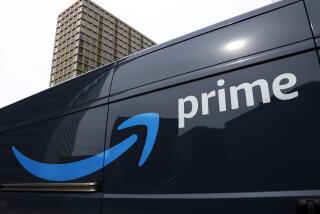5 Customers Sue AOL Over New Unlimited Access Plan
- Share via
When America Online initiated its unlimited usage pricing plan last month, customers expected to spend more time connected to the popular commercial online service. But many have found the plan has forced them to spend less time online.
Five such frustrated customers sued America Online in Superior Court in Los Angeles this week. They claim the new pricing plan has encouraged so much network usage that it is virtually impossible to log in, a situation that they say gives them anything but unlimited access.
“They have been selling this unlimited use, and they didn’t plan to have sufficient hardware or software to handle the volume,” said Louis M. Marlin, the Orange-based attorney who represents the disgruntled AOL customers. “People are paying for unlimited service and they’re not getting unlimited service.”
The 13-page suit asks that AOL be prevented from signing up new customers until it has upgraded its network to handle the increased demand. The plaintiffs have also asked for refunds and damages of at least $20 million.
In a statement released late Tuesday, the Dulles, Va.-based company said: “We expect to prevail in the class-action suit addressing member access to AOL.”
Since customers were given the option of buying unlimited network access for $19.95 a month, AOL users have spent an average of 32 minutes online each day, more than twice as long as the daily average in September, said Tricia Primrose, a company spokeswoman. America Online has responded with an aggressive, $250-million plan to expand the network’s capacity over the next five months, she said.
The plaintiffs--Richard Basch, Robert Friedland, Jeffrey Rayden and James Kranz of Los Angeles County and Jason Cartwright of San Diego County--contacted Marlin’s law office over the weekend after being shut out of the computer network.
“One of them tried for an hour straight and could not get in, one of them tried 26 times and gave up, and another tried 32 times and gave up,” Marlin said.
Marlin is seeking to have the suit certified as a class action, which would include all of AOL’s 7 million customers. Another AOL user, Ezra Graber of Staten Island, sued the company on Monday in New York on similar grounds.
For the AOL customers to win their case, they would have to prove the company knew it could not handle the increased demand but advertised and sold the unlimited usage plan anyway, said Amelia Boss, a Temple University law professor who specializes in online issues.
“To knowingly offer a service that you know you cannot deliver is fraud in the classic sense,” Boss said. “I think AOL can raise the argument that they didn’t realize what the implications would be.”
Primrose said AOL initiated the plan to lure new customers and boosted network capacity to meet an expected surge in demand. What the company didn’t expect was an influx of new subscribers in October and November, which offset the network upgrades, she said.
Internet access providers such as AT&T; and Pacific Bell have popularized unlimited access plans and helped to contribute to an overload of the global computer network.
Southeastern Bell parent SBC Communications on Tuesday implemented a new technology to siphon off Internet traffic and relieve congestion on the phone network.
The technology could eventually be put to use in California, where Internet traffic is heaviest.
Some companies, like San Jose-based Netcom On-Line Communications, have abandoned pricing plans that offer unlimited network access. But Primrose said AOL is committed to its plan, and analysts said it would be premature to dump it after only six weeks.
The bigger problem for AOL is that fed-up customers could leave the service in droves, said Paul Saunders, a technology analyst with Van Kasper & Co. in San Francisco. That would be particularly harmful because the company has historically suffered from a high churn rate, he said.
AOL investors seemed unconcerned, bidding the company’s stock up $1.50 to close at $39.50 a share in New York Stock Exchange trading.







